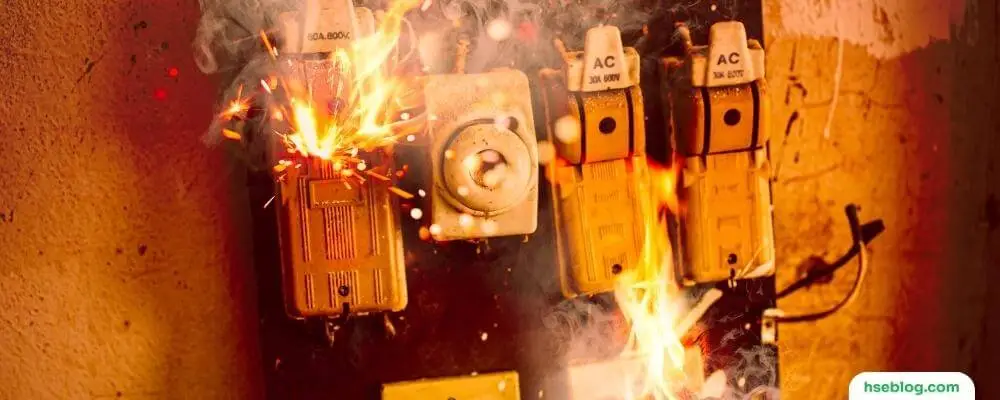

Understanding how to assess and manage fire risk is integral to maintaining a safe environment, whether a commercial building, an industrial complex, or a residential property. This critical process is not only a legal requirement in many regions, but it also plays a vital role in preventing potentially devastating fires, ensuring the safety of people, and protecting valuable assets.
Our latest blog post breaks down the complex fire risk assessment process into manageable steps. Whether you are a business owner, a safety officer, a property manager, or just someone interested in fire safety, this blog post will provide practical, step-by-step guidance.
From identifying potential hazards to implementing effective control measures, we’ll walk you through each stage of the assessment process. By the end of the post, you’ll have a clearer understanding of what a fire risk assessment entails, how to undertake one, and how to use the findings to create a safer environment.
With a focus on clarity and practical advice, this blog post demystifies the process of conducting a fire risk assessment, giving you the knowledge and confidence to carry out this essential safety procedure. Join us as we explore this vital topic and equip you with the tools to protect your premises and those within it from the fire threat.
A Fire Risk Assessment is a systematic and detailed examination of premises and its use to determine the likelihood of a fire starting and causing harm to those in and around it. This assessment is legally required in many jurisdictions for non-domestic premises to ensure the safety of occupants.
The Fire Risk Assessment process involves identifying the potential sources of ignition that could start a fire (such as electrical equipment or flammable substances), the materials that might fuel a fire (such as paper, wood, or flammable liquids), and the people who may be at risk. Once these elements have been identified, the risk is evaluated, considering existing fire safety measures and their effectiveness. This risk is evaluated in terms of the likelihood of a fire occurring and the potential severity of the consequences if a fire were to happen.
Following the evaluation, a plan is developed to eliminate or reduce the fire risk to an acceptable level. This plan could involve implementing additional fire safety measures, improving existing measures, or changing how certain work activities are carried out. Regular review and updates to the fire risk assessment are also part of the process to ensure that any changes in circumstances are considered. A Fire Risk Assessment aims to reduce the risk of a fire starting, limit the spread of fire if it does occur, and ensure that all occupants can safely escape from the premises.

Fire risk assessments are essential for several reasons, including legal responsibilities, personal safety, and potential cost savings. Here are some of the key benefits and importance of conducting a fire risk assessment:
A fire risk assessment is critical to managing a safe and efficient business environment. It ensures compliance with the law and significantly contributes to the business’s overall safety, financial stability, and reputation.

In a fire risk assessment, the analysis focuses on aspects of your work activities that could lead to fire-related harm. This assessment assists in identifying the chances of a fire starting and the potential dangers it presents to employees. The aim is to evaluate if the existing fire safety precautions are adequate for the identified risk or if further risk reduction measures are necessary.
"Fire Risk" refers to the potential likelihood of a fire happening multiplied by the severity of the potential fire outcomes - this includes loss of life and property damage.A fire hazard has the potential to cause harm, which is dependent on how likely it is to start a fire and the resulting consequences, such as property damage or loss of life. Assessing the potential harm is the responsibility of the assessor, who must evaluate the possible outcomes of the hazard.
The risk of ignition is a key consideration. Still, the assessor must also consider the frequency of occurrence and the factors that could contribute to it, such as human behavior, environmental conditions, and equipment usage. The potential for fire spread is influenced by several factors, including how long the fire may continue to burn undetected and whether it can jeopardize escape routes. Other factors influencing this include building construction (such as combustible materials or insufficient compartmentalization) and its contents (like flammable or explosive substances that could act as fuel).
The fire risk assessment must meet the following criteria:
Five steps are involved in the fire risk assessment process.

The first step in the fire risk assessment process involves identifying fire hazards within your establishment or workspace. Here’s what you need to look for:
By thoroughly identifying all possible fire hazards in this step, you lay a strong foundation for the rest of your fire risk assessment. This allows you to put effective measures in place to prevent fires and minimize their impact if they do occur.

The second step in the fire risk assessment process is to identify the individuals who may be particularly vulnerable in the event of a fire. This includes:
By identifying who is most at risk, you can create more effective fire safety strategies tailored to those individuals’ needs, reducing the overall risk and improving safety outcomes in case of a fire.

This stage involves assessing fire risks and the adequacy of current measures and considering improvements if necessary.
Based on your observations and analysis during the risk assessment, classify the building’s fire risk (likelihood of ignition) into the following categories:
| Low | Medium | High |
Considering the building’s structure, its occupants, and existing safety measures and procedures, determine the potential harm in case of a fire. Categories are:
| Slight harm | Moderate harm | Extreme harm |
Remember to consider sleeping occupants when assessing the level of harm.
Using the results from steps (1) and (2) above, use the table below to determine the risk rating.
| Potential consequences if a fire was to occur> Risk of a fire occurring | Slight harm | Moderate harm | Extreme harm |
| Low | Trivial risk | Tolerable risk | Moderate risk |
| Medium | Tolerable risk | Moderate risk | Substantial risk |
| High | Moderate risk | Substantial risk | Intolerable risk |
Accordingly, it is considered that the risk to life from fire at this building is:
| Trivial | Tolerable | Moderate | Substantial | Intolerable |
Using the table below, determine the action level and timescale for the risk rating from (3).
| Risk Level | Required Action & Timescale |
|---|---|
| Trivial | No need for immediate action or detailed record-keeping, but regular monitoring is recommended. |
| Tolerable | Significant new controls aren’t required. Regular monitoring is needed, and affordable improvements may be considered. |
| Moderate | Efforts should be focused on minimizing the risk. Risk reduction measures should be implemented within a specific timeline and monitored regularly. |
| Substantial | Significant resources may be needed to reduce risk. Unoccupied buildings should remain so until the risk is reduced. If the building is occupied, immediate action is required. |
| Intolerable | The area (or building) shouldn’t be occupied until the risk is reduced. Immediate action is necessary. |
If the existing fire safety measures are insufficient, consider how you could reduce or remove fire hazards. This could involve:
You can significantly reduce a fire’s risk and potential impact by evaluating and improving your current fire safety measures.

In this phase, it’s essential to record your findings, develop an emergency response plan, and provide necessary information and training to everyone who could be affected.
All hazards and at-risk individuals identified in steps 1 and 2 should be documented. The measures taken in step 3 to mitigate these risks should also be recorded. This documentation should be completed using the appropriate fire safety risk assessment form specific to your business type. The types of premises for which dedicated forms are available include:
If your premises do not fall into one of these categories, you can seek advice from your local safety authorities or relevant safety departments.
Following this, an emergency plan specific to your premises should be developed. This plan should outline the actions to be taken if there’s a fire within your property or in a nearby facility. Information on creating emergency plans can usually be sourced from your local fire service or online safety resources.
Finally, everyone involved should be informed about the identified fire risks, including employees and others who might be at risk. They should also be instructed on fire safety measures to manage these risks. Specific individuals, such as fire marshals or safety officers, may require additional training to handle emergency situations effectively. This step is crucial in ensuring everyone’s safety and equipping them with the necessary knowledge to respond appropriately in a fire emergency.

It’s essential to conduct regular reviews of your fire risk assessments to ensure they remain up-to-date and accurately reflect the current risks in your premises. Risks can change for several reasons, and an outdated assessment can leave you ill-prepared to handle potential fire hazards.
If there has been a significant change in the level of risk at your premises, or if there’s been a close call, you should revisit and revise your fire risk assessment promptly.
Factors that might prompt a review include:
By routinely reviewing and updating your fire risk assessments, you can keep ahead of changing risks and ensure that your fire prevention strategies and emergency response plans are effective and suitable for your evolving workplace conditions.

Professional assessors have a pivotal part in conducting fire risk assessments. They ensure that businesses fulfill legal obligations and enhance their fire safety measures. Here’s what you can anticipate from a professional assessor during a fire risk assessment:
Choosing a professional assessor requires verifying their educational background and skillset. In the UK, for instance, assessors should have completed training accredited by the Fire Risk Assessment Competency Council (FRACC) or a similar recognized course.
They should also carry a track record of executing fire risk assessments for companies that operate in the same sector as yours. Moreover, assessors need to possess a profound understanding of the local fire safety regulations and standards.
A professional assessor thoroughly evaluates your workplace during a fire risk assessment. They identify potential fire risks and examine the effectiveness of your current fire safety measures. Based on their evaluation, the assessor provides recommendations, such as upgrading fire safety equipment or enhancing evacuation paths. The evaluation also encompasses analyzing the building’s architectural design, including the materials utilized and the structural layout.
Upon the conclusion of the assessment, the professional assessor delivers a comprehensive report encapsulating their findings and advice. This report contains a synopsis of the assessment, a catalog of pinpointed hazards, and an elaborate action plan for addressing them.
The report should also include a ranked list of suggestions, considering any financial or temporal restrictions. Proper documentation is crucial for proving adherence to regulations and for future reference if modifications are made to the workplace. In essence, employing a professional assessor aids businesses in complying with legal stipulations, enhancing fire safety measures, and safeguarding their staff and assets.

Selecting a professional fire risk assessor is a significant step in guaranteeing your business’s safety and legal compliance. Here’s how you can approach this important decision:
Conducting fire risk assessments with professional assessors can help prevent accidents, mitigate liability, and result in long-term financial savings.
What is fire risk assessment?Fire risk assessment is a systematic process designed to identify potential fire hazards, evaluate the associated risks, and determine appropriate measures to eliminate or control these risks. It is an integral part of ensuring the safety of a building or premises and its occupants. The main objectives are to reduce the likelihood of a fire starting, protect people and property, and ensure compliance with local fire safety regulations.
The assessment process involves identifying sources of ignition and fuel, evaluating fire detection and prevention measures, and reviewing fire escape routes and emergency procedures. The findings are then recorded and reviewed regularly or when significant changes occur in the premises.
What are the steps in the fire risk assessment?The fire risk assessment process generally consists of the following steps:
A fire risk assessment checklist is a tool used to systematically identify and evaluate potential fire hazards in a premises, evaluate the effectiveness of existing fire safety measures, and determine what actions need to be taken to mitigate the identified risks. It typically covers areas such as:
Remember, this is a general list, and a checklist should be tailored to the specifics of your premises and activities. Also, a checklist is only a tool to aid in the assessment and does not replace the need for a comprehensive and competent fire risk assessment.
Who is responsible for completing a fire risk assessment?The responsibility for carrying out a fire risk assessment typically lies with the person or people who control or part of the premises. This is often referred to as the ‘Responsible Person’. In a workplace, this is usually the employer or business owner.
However, this responsibility can also fall onto:
Regardless of who the responsible person is, it’s important to note that they cannot delegate the responsibility of fire safety. Even if they hire a professional risk assessor, the final accountability remains with the responsible person. If the responsible person is not competent to carry out the risk assessment, they should appoint a ‘competent person’ to help, such as a professional risk assessor.
The responsible person must ensure the fire risk assessment is carried out and reviewed regularly and that the necessary changes are implemented. This includes informing and training staff about the risks and actions they must take in an emergency.
What is the NFPA code for fire risk assessment?The National Fire Protection Association (NFPA) in the United States develops and maintains numerous codes and standards related to fire safety, including those that pertain to fire risk assessment.
NFPA 551: Guide for the Evaluation of Fire Risk Assessments is the document that provides guidance on the principles and techniques of fire risk assessment. It is designed to help users understand and apply the risk assessment methods found in NFPA codes and standards.
Another significant standard is NFPA 101: Life Safety Code, which outlines comprehensive building design and operation requirements to promote safety and prevent fire-related injuries and fatalities. It includes guidelines on conducting a risk assessment in its performance-based design option.
Please note that these documents are updated regularly and that it’s important to consult the most current version. Additionally, the specific NFPA code or standard that applies can depend on the specific context, building type, or industry. Please consult the NFPA or a fire safety professional for comprehensive and up-to-date information.
The fire risk assessment process is a critical endeavor ensuring people’s and property’s safety and well-being. Businesses and individuals can effectively evaluate and manage fire risks by following a step-by-step approach, from identifying hazards to implementing control measures. Our comprehensive guide has provided valuable insights and practical guidance on conducting a fire risk assessment.
By embracing this process and taking appropriate actions based on the findings, we can create safer environments and mitigate the potentially devastating consequences of fires. Prioritizing fire safety is an ongoing commitment that safeguards lives, instills confidence, and promotes a culture of preparedness.